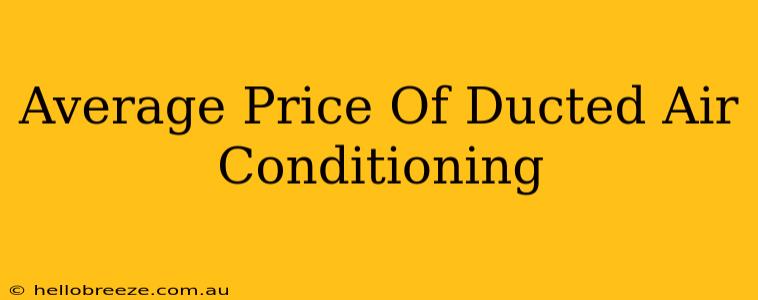Thinking about installing ducted air conditioning? It's a significant investment, so understanding the average price is crucial. This guide breaks down the costs, influencing factors, and how to get the best value for your money.
Understanding the Variables Affecting Ducted AC Costs
The price of ducted air conditioning varies dramatically depending on several key factors. There's no single "average" price that applies universally. Instead, consider these crucial elements:
1. System Size and Capacity:
This is the biggest driver of cost. Larger homes or those with more rooms require more powerful systems, leading to a higher price tag. A smaller, less powerful system for a studio apartment will be significantly cheaper than a large system for a five-bedroom house. Capacity is measured in kilowatts (kW) – the higher the kW rating, the more powerful (and expensive) the system.
2. Type of System:
- Reverse Cycle: These systems provide both heating and cooling, offering year-round comfort. They are generally more expensive upfront than single-purpose systems but often save money in the long run.
- Single-Purpose: These systems only provide either heating or cooling. They are typically less expensive initially but lack the versatility of a reverse cycle system.
3. Installation Complexity:
The complexity of the installation significantly impacts the final cost. Factors include:
- Home Size and Layout: A complex house layout with difficult-to-reach areas will increase labor costs.
- Existing Ductwork: If you have existing ductwork that can be reused, it can lower the overall cost. New ductwork installation is a major expense.
- Insulation Requirements: Proper insulation is vital for efficiency. The cost of insulation will be added to the overall project price.
4. Brand and Quality:
Different brands offer varying levels of quality, features, and energy efficiency. Premium brands often come with a higher price tag, but they may offer better performance, longer warranties, and lower running costs over the system's lifespan. Researching reputable brands is key to ensuring you receive a quality product.
5. Location:
Labor and material costs vary by region. Installation in a remote area may be more expensive due to travel time and potentially higher labor rates.
Typical Cost Ranges
While pinpointing an exact average is impossible, here's a general idea of price ranges (as of late 2023; always check current pricing with local installers):
- Small System (1-2 bedrooms): $5,000 - $10,000
- Medium System (3-4 bedrooms): $10,000 - $18,000
- Large System (5+ bedrooms): $18,000 - $35,000+
Note: These are estimates and exclude any additional costs like permits, upgrades (e.g., zoning systems), or unexpected issues discovered during the installation process.
Getting the Best Value
To get the best value for your investment:
- Get Multiple Quotes: Compare quotes from at least three different reputable installers. Make sure the quotes include a detailed breakdown of costs.
- Consider Energy Efficiency: Look for systems with high SEER (Seasonal Energy Efficiency Ratio) ratings. Higher SEER ratings mean lower energy bills.
- Check Warranties: Understand the warranty coverage provided by the manufacturer and installer.
- Ask About Financing Options: Some installers offer financing plans to make the investment more manageable.
Investing in ducted air conditioning can dramatically improve your home's comfort and value. By understanding the factors influencing cost and following these tips, you can make an informed decision and get the best possible system for your needs and budget. Remember to always contact local professionals for accurate, up-to-date pricing information.

